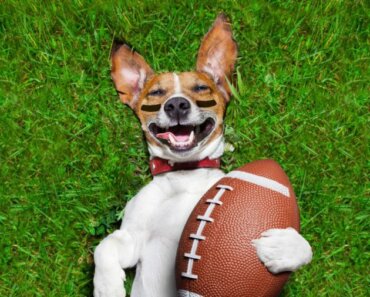Most dogs are less active during the winter months. Find out how Tui na can help prevent early season injuries as your canine “springs into action” again.
Spring is in the air and your dog knows it. She wants to run, play, and frolic. It fun to see her feeling so exuberant — but is she really ready to “spring into action” after being a couch potato all winter? This is exactly when injuries often happen. Let’s look at why, and learn how the ancient Chinese technique of acupressure-massage — also known as Tui na — can help keep your dog from hurting herself.
THE BODY’S “RUBBER BANDS”
Muscles, tendons, and ligaments are the “rubber bands” of the body. If they’re tight, stiff, or cold, they can’t perform their job, which is to comfortably flex the dog’s neck,  trunk, and limbs. The tendons attach the muscles to the bones to form a lever system. One muscle and its tendon extend the limb forward, and the opposite muscle and tendon draw the limb back. Ligaments hold the joints together; they are attached to the bony structures so they can stabilize the joints.
trunk, and limbs. The tendons attach the muscles to the bones to form a lever system. One muscle and its tendon extend the limb forward, and the opposite muscle and tendon draw the limb back. Ligaments hold the joints together; they are attached to the bony structures so they can stabilize the joints.
After a period of limited running, playing and jumping, such as often occurs during the winter months, sudden vigorous activity can cause the muscles, tendons, and ligaments to snap off the bone or tear. The older the dog, the more conscientious you have to be about rebuilding and strengthening her muscles, even when you start up the exercise slowly and carefully. Young dogs have more capacity to bounce, stretch, and move with ease — as long as they don’t overdo it.
FAST FACT: Another issue to watch for is when your dog’s muscles tire; many an injury results from shaky, tired muscles.
ANCIENT CHINESE ACUPRESSURE-MASSAGE
Ancient Chinese medicine doctors used acupressure-massage techniques to enhance flexibility and warm muscles and joints. These techniques are referred to as Tui Na (pronounced “tway nah”). They are an important part of Chinese medicine and have been used on both animals and humans for thousands of years.
Some Tai na techniques are warming in nature because they bring nourishing blood and Chi (life-promoting energy) to the affected area of the body.
FAST FACT: These techniques enhance the flexibility and stability of the surrounding muscles, tendon attachments, and joints.
The two techniques we are going to explore here are considered rubbing techniques that warm, increase circulation, and invigorate the tissues. They may seem superficial, but they loosen the fascia — the fibrous layers of tissue below the surface of the skin — and open up the muscles beneath the fascia. In this way, they prepare the tissues for movement.
TRY THESE TUI NA TECHNIQUES
1. Mo Fa (“moo fa”) involves rubbing in a circular motion. Use the soft pad of your middle finger or the palm of your hand, depending on the size of your dog, and gently move your hand in a circular rotation. Keep your wrists and hands relaxed. Begin slowly with light pressure, then after about ten rotations, increase the speed and pressure until you feel the warmth of the tissues.

Mo Fa can be applied directly on muscles and joints. You can shift the circular motion along the neck, trunk, and limbs.
FAST FACT: This technique is instinctive when either you or your dog are hurt or feel stiff.
2. Cou Fa (“soo fa”) is a gentle yet vigorous technique that must be applied rhythmically. Place one hand below the limb and the other on top. Start closer to the hip and move your hands opposite each other, forward and back, while slowly moving them down the dog’s leg. Again, press down gently at first, then increase the speed and depth of pressure until you feel the tissues moving lightly under your hands. Repeat this action three to four times.
down the dog’s leg. Again, press down gently at first, then increase the speed and depth of pressure until you feel the tissues moving lightly under your hands. Repeat this action three to four times.
Cou Fa can be applied from the top of a limb down to the paw; from head to shoulder on the neck; or shoulder to tail on the trunk. As needed, repeat this technique three times on your dog’s limbs, neck or trunk, to warm and feel the gentle movement of the fascia and muscles beneath. Early season injuries can be painful, and put a real damper on the rest of your dog’s spring and summer fun. Start the season off right with these two Tui Na techniques, applying them to your dog before heading out for a walk, run or romp. It can make a huge difference.





























